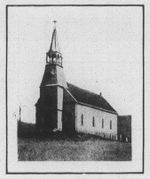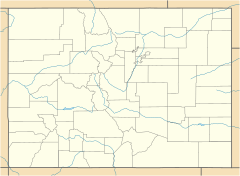Primero, Colorado facts for kids
Quick facts for kids
Primero
|
|
|---|---|
|
Mining ghost town
|
|

Catholic church in Primero built by CF&I, 1914
|
|
| Country | United States |
| State | Colorado |
| County | Las Animas |
| Elevation | 6,814 ft (2,077 m) |
| Time zone | UTC-7 (Mountain (MST)) |
| • Summer (DST) | UTC-6 (MDT) |
| ZIP codes |
81233
|
| GNIS feature ID | 194641 |
Primero is a ghost town in Las Animas County, Colorado, United States. It used to be a busy company town where people worked for the Colorado Fuel and Iron Company (CF&I) in the early 1900s. They mined coal there.
Contents
What Was Primero?
Primero was one of the very first mining towns in its area, which is how it got its name (Primero means "first" in Spanish). By 1921, about 275 miners worked there. The town grew to have 175 buildings. These included a Catholic church, a Protestant church, and even a high school. The Union Protestant church opened in April 1917. It was a place for worship and also for fun community events.
Coal and Steel
The coal from Primero was mostly used to make steel. It went to CF&I's big steel plants in Pueblo (called the Minnequa Steel Works) and Segundo. When the steel plants needed less coal, it affected the Primero mine. This was part of a big disagreement between the miners and the company in 1921. Over its lifetime, the Primero mine produced over 8 million tons of coal.
Primero's Story
A post office opened in Primero in 1901. It stayed open until 1933.
A Tragic Accident
On January 31, 1910, a terrible explosion happened at the Primero mine. Sadly, 75 miners lost their lives. This accident showed how dangerous mining conditions could be before a big strike in 1913-1914. Later that year, on November 8, 1910, another explosion happened at a mine in Delagua, killing 76 people. Miners from Primero bravely helped to find survivors and recover bodies from the wreckage.
The Coalfield War
In September 1913, the United Mine Workers of America (UMWA) trade union called for a strike against CF&I. Over the next few months, there were many conflicts, and some people in Primero were affected. The situation became much worse on April 20, 1914. This was when the Colorado National Guard and company-supported groups attacked striking miners in what is known as the Ludlow Massacre. This event led to even more conflict in what is now called the Colorado Coalfield War.
Changes and Challenges
After the strike, John D. Rockefeller Jr., who was in charge of CF&I, worked with William Lyon Mackenzie King (who later became Prime Minister of Canada) to make changes. They wanted to improve things for the workers and gain their support. CF&I invested in new buildings and services in its towns. One new building was a Catholic church in Primero. Before the Protestant church was finished, this Catholic church was used by different Christian groups for their services. In May 1921, Bishop John Henry Tihen visited the church and confirmed 17 children.
During World War I, at least 48 men from Primero joined the United States military. The town also helped the war effort by buying $34,900 worth of liberty bonds. This would be like $550,000 today.
In 1921, miners went on strike again for several months, from August to November. This was because of disagreements over pay. Many miners left Primero during this time. The miners wanted to be represented by the UMWA, but CF&I did not allow it. Instead, the company wanted them to use a company-run union. In the end, Colorado's Industrial Commission agreed with the company. They said that miners could not join the UMWA and had to accept the wages set by the company's union.
Primero's End
By 1928, most people had moved out of Primero. By August 1, 1933, everything that was left in the town was either sold or taken apart.


